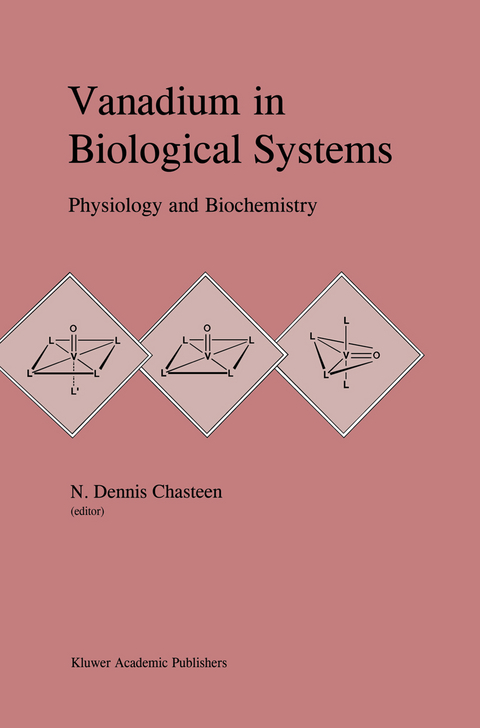
Vanadium in Biological Systems
Physiology and Biochemistry
Seiten
2011
|
Softcover reprint of the original 1st ed. 1990
Springer (Verlag)
978-94-010-7407-0 (ISBN)
Springer (Verlag)
978-94-010-7407-0 (ISBN)
Over the past several decades, vanadium has increasingly attracted the interest of biologists and chemists. The discovery by Cantley in 1977 that vanadate is a potent inhibitor of ATPases lead to numerous studies of the inhibitory and stimulatory effects of vanadium on phosphate metabolizing enzymes.
Over the past several decades, vanadium has increasingly attracted the interest of biologists and chemists. The discovery by Henze in 1911 that certain marine ascidians accumulate the metal in their blood cells in unusually large quantities has done much to stimulate research on the role of vanadium in biology. In the intervening years, a large number of studies have been carried out to investigate the toxicity of vanadium in higher animals and to determine whether it is an essential trace element. That vanadium is a required element for a few selected organisms is now well established. Whether vanadium is essential for humans remains unclear although evidence increasingly suggests that it probably is. The discovery by Cantley in 1977 that vanadate is a potent inhibitor of ATPases lead to numerous studies of the inhibitory and stimulatory effects of vanadium on phosphate metabolizing enzymes. As a consequence vanadates are now routinely used as probes to investigate the mechanisms of such enzymes. Our understanding of vanadium in these systems has been further enhanced by the work of Tracy and Gresser which has shown striking parallels between the chemistry of vanadates and phosphates and their biological compounds. The observation by Shechter and Karlish, and Dubyak and Kleinzeller in 1980 that vanadate is an insulin mimetic agent has opened a new area of research dealing with the hormonal effects of vanadium. The first vanadium containing enzyme, a bromoperoxidase from the marine alga Ascophyllum nodosum, was isolated in 1984 by Viltner.
Over the past several decades, vanadium has increasingly attracted the interest of biologists and chemists. The discovery by Henze in 1911 that certain marine ascidians accumulate the metal in their blood cells in unusually large quantities has done much to stimulate research on the role of vanadium in biology. In the intervening years, a large number of studies have been carried out to investigate the toxicity of vanadium in higher animals and to determine whether it is an essential trace element. That vanadium is a required element for a few selected organisms is now well established. Whether vanadium is essential for humans remains unclear although evidence increasingly suggests that it probably is. The discovery by Cantley in 1977 that vanadate is a potent inhibitor of ATPases lead to numerous studies of the inhibitory and stimulatory effects of vanadium on phosphate metabolizing enzymes. As a consequence vanadates are now routinely used as probes to investigate the mechanisms of such enzymes. Our understanding of vanadium in these systems has been further enhanced by the work of Tracy and Gresser which has shown striking parallels between the chemistry of vanadates and phosphates and their biological compounds. The observation by Shechter and Karlish, and Dubyak and Kleinzeller in 1980 that vanadate is an insulin mimetic agent has opened a new area of research dealing with the hormonal effects of vanadium. The first vanadium containing enzyme, a bromoperoxidase from the marine alga Ascophyllum nodosum, was isolated in 1984 by Viltner.
I. Vanadium in the Biosphere.- II. The Coordination and Redox Chemistry of Vanadium in Aqueous Solution.- III. The Essentiality and Metabolism of Vanadium.- IV. Vanadates as Phosphate Analogs in Biochemistry.- V. Vanadium Haloperoxidases.- VI. Vanadium Nitrogenases.- VII. Insulin Mimetic Effects of Vanadium.- VIII. Vanadate Sensitized Photocleavage of Proteins.- IX. Vanadium in Ascidians.- X. Biological Applications of 51V NMR Spectroscopy.- XI. Biological Applications of EPR, ENDOR, and ESEEM Spectroscopy.
| Zusatzinfo | VIII, 226 p. |
|---|---|
| Verlagsort | Dordrecht |
| Sprache | englisch |
| Maße | 155 x 235 mm |
| Themenwelt | Sachbuch/Ratgeber ► Natur / Technik ► Garten |
| Medizin / Pharmazie ► Medizinische Fachgebiete ► Pharmakologie / Pharmakotherapie | |
| Naturwissenschaften ► Biologie ► Biochemie | |
| Naturwissenschaften ► Chemie ► Anorganische Chemie | |
| ISBN-10 | 94-010-7407-0 / 9401074070 |
| ISBN-13 | 978-94-010-7407-0 / 9789401074070 |
| Zustand | Neuware |
| Informationen gemäß Produktsicherheitsverordnung (GPSR) | |
| Haben Sie eine Frage zum Produkt? |
Mehr entdecken
aus dem Bereich
aus dem Bereich
Obst- und Ziergehölze, Stauden, Kübel- und Zimmerpflanzen richtig …
Buch | Hardcover (2023)
Gräfe und Unzer (Verlag)
34,00 €


